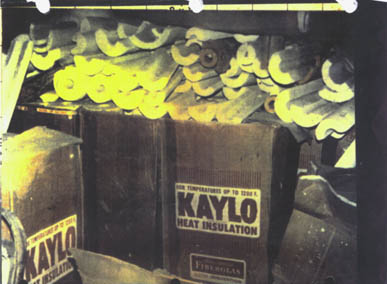Asbestos-Containing Products
Millions of buildings in the United States still contain asbestos and there are new products sold every day – brake pads, roofing and packing materials, floor tile. Contrary to popular misconception asbestos is not banned in the United States. And it is not just old “legacy” asbestos that is a problem. New products continue to be sold with asbestos.
Click the following for partial lists of:
- Household items that were made with asbestos
- Asbestos-containing products, their brand names and dates they were sold
- Companies that made and sold asbestos products
Many large corporations were involved in making and selling asbestos products. The industry has been  very influential in preventing the banning of asbestos despite the health hazards they know the material poses. These are some of the corporations we typically target.
very influential in preventing the banning of asbestos despite the health hazards they know the material poses. These are some of the corporations we typically target.
In the mid-1980s, scientific concern about asbestos hazards prompted the Environmental Protection Agency (EPA) to propose a ban on all asbestos-containing products. The industry challenged the ban in court and commissioned a massive compilation of information on the benefits, as well as the potential risks for human exposure. Based on this information, the U.S. Court of Appeals for the Fifth Circuit found such a ban unwarranted. The court echoed the industry and said:
- No significant human exposures to asbestos fibers would occur if the products were produced and used under controlled conditions;
- Substitutes for asbestos-containing products themselves posed potential human health risks that could be more significant than any potential risks from asbestos;
- Asbestos-containing products offered significant benefits not offered by substitute products.
The court’s decision effectively allowed any product that had included asbestos before 1989 to continue to be sold with asbestos. The EPA was allowed to prohibit the introduction of new products with asbestos. Click here for a breakdown of prohibited and authorized asbestos products.
Despite the industry’s triumph in court, public health officials are still trying to get the word out about the dangers of asbestos, and many regulatory agencies are doing their best to minimize further exposure to Americans.
The production and use of asbestos-containing products are regulated by the EPA, the Occupational Safety and Health Association (OSHA) and the Department of Transportation (DOT). The EPA regulates air and water emissions from facilities which manufacture asbestos products and provides rules for the  disposal of asbestos-containing waste. OSHA has established a health standard for workers with potential asbestos exposure and sets a stringent limit on airborne exposure. The DOT regulates the transport of asbestos.
disposal of asbestos-containing waste. OSHA has established a health standard for workers with potential asbestos exposure and sets a stringent limit on airborne exposure. The DOT regulates the transport of asbestos.
Even with these safeguards in place, asbestos continues to kill. (Click for close-up autopsy pictures of mesothelioma tumors. Warning: graphic material.) Mt. Sinai Medical Center in New York predicts that by 2030, more than 400,000 deaths will result from asbestos exposure – more than the number killed in World War II. Click here for an article on Mesothelioma: An Emerging Epidemic.
Some countries have taken steps to ban asbestos. In the United States, however, it is legal to sell products with asbestos in them. Click here for a history of the EPA’s attempt to ban asbestos.
News Stories about Asbestos Companies
W.R. Grace Charged in Asbestos Case – Feb 2005
Halliburton: $4.7B Asbestos Deal Closed
Pfizer to Take $369 Million Asbestos Charge.
3M asks Congress for help in lawsuits for masks.
Automakers see asbestos lawsuits rise.
General Electric loses asbestos court case.
W.R. Grace files for bankruptcy
Collapse of World Trade Center disperses asbestos, increase health risk
Tumor suppressor gene alterations in patients with malignant mesothelioma
Related: types of asbestos
